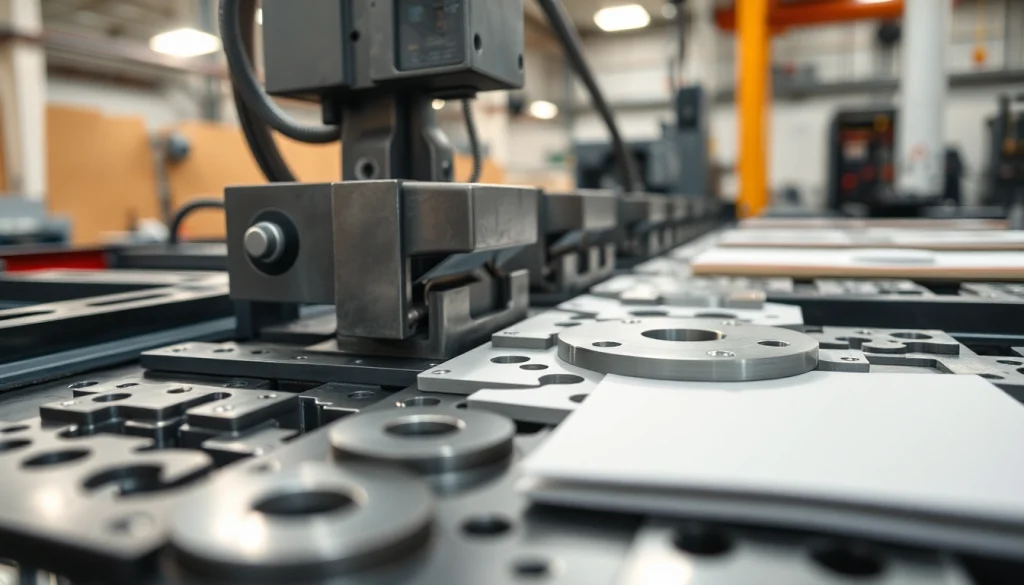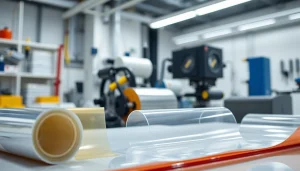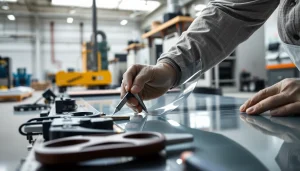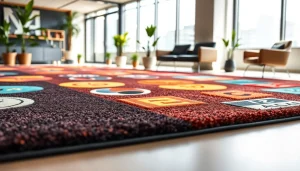Enhancing Production Efficiency with Precision Die Cutting Techniques

Understanding Precision Die Cutting
Precision die cutting is a manufacturing process that involves the use of custom-made tools (dies) to cut materials into specific shapes with remarkable accuracy and efficiency. Unlike traditional cutting methods, precision die cutting is employed in various industrial applications to produce parts that require high tolerances and consistent results. The flexibility and adaptability of precision die cutting allow it to cater to numerous industries, including automotive, healthcare, electronics, and packaging.
What is Precision Die Cutting?
At its core, precision die cutting is a process used to convert sheets or rolls of raw materials into intricately designed shapes by utilizing cutting tools known as dies. These dies can be formed from various materials, including steel, and are tailored specifically for each project, thereby enhancing production efficiency.
The process is often carried out using different techniques such as flatbed, rotary, or laser die cutting, each with its unique advantages depending on the complexity and volume of parts to be produced. This capacity to create highly detailed shapes makes precision die cutting a preferred choice for companies looking to maintain quality while optimizing their operations.
The Importance of Precision in Various Industries
Precision die cutting plays an essential role in manufacturing and production processes, particularly in industries requiring high standards of quality. Industries such as automotive use precision die-cut components for gaskets, seals, and insulation, where even a minute variance can lead to performance failures. Similarly, the healthcare industry relies on precision die-cut parts to ensure that components fit together seamlessly, preventing contamination and ensuring product efficacy.
In the electronics sector, precision die cutting is vital for creating components that are lightweight yet durable—such as circuit board components—affecting both performance and the overall product design. In packaging, precision die cutting is used to create unique box designs that protect products while ensuring aesthetic appeal, significantly impacting consumer attraction and brand perception.
Key Components of Precision Die Cutting Machines
A precision die cutting machine consists of several components that work in tandem to achieve accuracy in cutting. Key components include:
- The Die: Custom blades used to make precise cuts. Steel rule dies are common due to their durability and cost-effectiveness, while rotary dies cater to higher production needs.
- Cutting Bed: The flat surface where materials are placed for cutting. It often includes registration marks to ensure accurate positioning.
- Feed Mechanism: This part feeds material into the machine. Automated feed systems enhance efficiency by minimizing human error.
- Pressure System: Accurate pressure is exerted on the die to cut through the material, critical for ensuring clean edges and maintaining material integrity.
Types of Precision Die Cutting Techniques
Flatbed Die Cutting Explained
Flatbed die cutting utilizes a flat platform where the die is pressed onto the material, typically sheets. This method is particularly effective for thicker materials and is known for its versatility across various applications.
The flatbed press works by lowering the die onto the material, pressing it down with significant force to cut through. This technique is frequently employed for custom designs, especially when working with non-rolling materials, as it provides the capability to punch out complex shapes consistently.
While flatbed die cutting is slower compared to rotary methods, it is ideal for small to medium production runs and custom applications where precision is paramount.
Rotary Die Cutting: Benefits and Applications
Rotary die cutting employs a cylindrical die that continuous feeds material around a rotating mandrel. This method is best suited for high-volume production due to its speed and efficiency.
Rotary die cutting can simultaneously perform several tasks such as cutting, embossing, and even printing, making it extremely versatile. Industries commonly using rotary die cutting include packaging, where speed and precision are essential for maintaining production timelines and costs.
The main advantage of rotary die cutting is its high throughput capacity, which can be critical for large-scale operations. Moreover, the process offers a high degree of accuracy, enabling the production of intricate designs with minimal material waste.
Laser Die Cutting: Precision at Its Best
Laser die cutting uses powerful laser beams to cut through materials with extreme precision. This method is incredibly flexible, allowing manufacturers to cut complex shapes without the need for physical dies. As a result, laser cutting is ideal for prototyping and applications where design changes are frequent.
While laser die cutting can be slower than traditional methods, it compensates for this with its ability to achieve high precision even on intricate designs. Industries such as aerospace and medical devices often utilize laser die cutting due to the critical nature of their components, which must meet stringent quality and accuracy standards.
Common Materials Used in Precision Die Cutting
Foams, Films, and Plastics
Materials such as foams, films, and plastics are among the most commonly die-cut substances due to their versatility and prevalence in various applications. Foam materials, including polyethylene and polyurethane, are frequently used for insulation, cushioning, and packaging.
Films, such as PET and PVC, are also popular due to their lightweight nature and compatibility with many printing processes. These materials are commonly used in medical and electronics applications, where custom shapes and sizes are crucial.
Plastics, including acrylic and polycarbonate, provide durability and strength and are often used in consumer products, automotive components, and electronic housing. Precision die cutting ensures that these materials can be formed into various shapes while retaining their essential properties.
Metal Components and Their Uses
Precision die cutting is also applied in cutting metal components, which are essential in automotive and aerospace industries. Materials such as aluminum, brass, and stainless steel can be cut with precision for components like brackets, plates, or custom housings.
Die-cut metal parts are often used in high-stress environments where strength and reliability are critical. Therefore, maintaining tight tolerances in the cutting process is vital for product integrity and performance in these applications.
Additionally, laser cutting technology has expanded the capabilities of metal die cutting, allowing manufacturers to create complex designs while minimizing waste and ensuring high-quality finishes.
Adhesives and Specialty Materials
Precision die cutting is often employed to create custom shapes from adhesive materials and specialty substrates. Adhesive-backed films and foams, commonly used in signage and packaging, require a precise cutting process to ensure that they can be applied correctly without bubbles or wrinkles.
Specialty materials such as silicone, rubber, and composites may also be die-cut to meet specific application needs, especially in applications requiring resilient and flexible materials, like automotive seals or gaskets.
This wide range of materials showcases the versatility of precision die cutting, allowing businesses to produce components that fulfill specific requirements across industries.
Advantages of Precision Die Cutting
Cost-Effectiveness and Material Savings
One of the primary advantages of precision die cutting is its cost-effectiveness, especially in mass production settings. By minimizing material waste through precise cutting techniques, companies can significantly reduce raw material costs.
Additionally, the efficiency of die cutting processes minimizes labor costs and reduces production time, allowing businesses to meet high throughput requirements without sacrificing quality. This ensures competitive pricing while maintaining margins, which is particularly critical in industries with tight profit margins.
Reduction of Production Time
Precision die cutting accelerates the manufacturing process, drastically cutting lead times when compared to manual or traditional cutting methods. Automated die cutting systems enable fast setup and processing of multiple units, allowing businesses to respond rapidly to market demand.
As a result, manufacturers can take on larger orders and meet tight deadlines without the need for additional resources. This accelerated production speed can provide a valuable competitive edge in industries where time-to-market is crucial.
Quality and Consistency in Production
Precision die cutting achieves highly consistent results, ensuring that each product meets the required specifications without variation. This quality control is essential for maintaining standards, especially in industries like aerospace and medical devices where safety is paramount.
Furthermore, die cutting minimizes the risk of human error, resulting in fewer defects and a more streamlined workflow. By enhancing quality control, businesses can improve customer satisfaction and reduce returns related to inconsistent product quality.
Implementing Precision Die Cutting in Your Operations
Choosing the Right Die Cutting Partner
Selecting the right die cutting vendor is critical for ensuring a successful implementation of precision die cutting in your operations. Companies should look for partners with extensive experience in the specific materials and techniques relevant to their industry.
Key considerations include the vendor’s technological capabilities, their commitment to quality control, and the ability to provide customized solutions that align with your production goals. Establishing a strong partnership will facilitate clear communication and collaboration, resulting in more effective outcomes.
Best Practices for an Efficient Workflow
To achieve maximum efficiency in precision die cutting operations, organizations should implement best practices such as:
- Streamlined Communication: Ensure clear communication between design teams and die cutting operators to avoid misunderstandings regarding specifications and material choices.
- Regular Maintenance: Perform routine checks and maintenance on die cutting machines to prevent downtime and ensure optimal performance.
- Quality Control Processes: Implement strict quality control measures to scrutinize the output regularly and ensure all die-cut components meet required standards.
- Utilization of Prototypes: Develop prototypes before full production runs to test designs and make necessary adjustments for better accuracy and efficiency.
Measuring Success and Optimizing Processes
Success metrics for precision die cutting operations should include tracking production output, quality rates, material waste, and turnaround times. By assessing these factors, organizations can identify areas for improvement and develop strategies to enhance overall performance.
Continuous optimization should be part of the die cutting strategy. This entails regularly reviewing processes, investing in employee training, and exploring new technologies that could streamline operations further and enhance operational efficiency.






